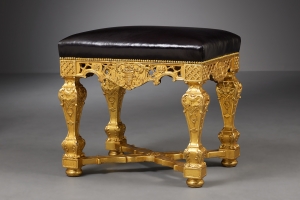Hendrik Voogd (Amsterdam 1768 – 1839 Rome)
Hendrik Voogd (Amsterdam 1768 – 1839 Rome)
Italianate landscape with resting cattle and a shepherd couple, an approaching storm beyond, ca. 1815
This never-before-published painting of cattle and shepherds in an Italianate landscape with an approaching storm in the distance is a beautiful addition to the small but renowned oeuvre of the Dutch painter Hendrik Voogd. That the artist was long forgotten in the Netherlands may perhaps be blamed on his lengthy stay in Italy.
Hendrik Voogd was apprenticed in Amsterdam to the painter Jurriaan Andriessen (1742-1819), who was specialised in wall hangings and interior decoration. In 1788, the Amsterdam patron Dirk Versteegh’s financial support allowed Voogd to travel to Rome to continue his studies. He was thus one of the first Dutch painters to reside in the eternal city after earlier artists had worked there during the seventeenth century. Jean Grandjean (1752-1781) and Daniël Dupré (1751-1817), who were also pupils of Andriessen, had preceded Voogd. Upon his arrival, however, Grandjean had died already and Dupré would return to his native country a few years later in 1791.
Voogd lived in Rome with the Dutch artist David Humbert de Superville (1770-1849), who arrived in the city shortly after him. He was also in close contact with the German painters of the large international artistic community who resided in the Italian capital at the time.
In 1805, Voogd was visited by the Dutch playwright Adriaan Van der Willigen (1766-1841), who is now best remembered for his biographies of artists from the Netherlands. According to Van der Willigen, Hendrik Voogd was nicknamed the ‘Dutch Claude Lorrain’. Despite attempts by Van der Willigen to persuade the artist to return to the Netherlands, Voogd would remain in Rome until his death in 1839.
Numerous paintings featuring the Roman Campagna were sent to the Netherlands, where they were highly praised at the exhibitions of ‘Living Masters’. His patron Dirk Versteegh regularly received work from the artist as well.
Works by Hendrik Voogd are rare today. According to the art-historical literature at hand, approximately thirty of the sixty paintings of his oeuvre remain, and roughly four hundred (preparatory) drawings. However, upon examining what has survived the hands of time, it is easy to follow Voogd's artistic development. At the start of his career he mainly painted meticulously composed, classical landscapes. His repertoire would later shift from the ‘paysage historique’ to the more dramatic scenes with light effects, such as our composition with an approaching storm. It is noteworthy that livestock do not occur in his earliest landscapes, a motif which has a prominent role in Voogd’s works after 1810.
For his paintings, Hendrik Voogd often made use of the many drawings he had acquired at an auction in 1842. These ‘plein-air’ studies, which often included topographical indications, were frequently referred to by the artist. In the work at hand, the bare trees on the right derive from these drawings, as does the vegetation growing from the rocks to the left, for example. The horned cows are also recognizable as typical ‘Guardian’ cattle.
Literature:
C.J. de Bruijn Kops, 'Hendrik Voogd, landschapschilder', Nederlands Kunsthistorisch Jaarboek 21 (1970), pp. 319-369
F.Kuyvenhoven, 'De Leidse collectie tekeningen en grafiek van Hendrik Voogd', Leids Kunsthistorisch Jaarboek 4 (1985), pp. 269-295
- Provenance
- Private collection
- Period
- ca. 1815
- Material
- oil on canvas
- Signature
- H. Voogd fecit [lower left]
- Dimensions
- 62.5 x 86.4 cm
Global shipping available









